
【Exclusive Interview】Part 2 : James Zorab – Lowland Bond – Edinburgh Whisky
- 造り手
- 樽・蒸留器・倉庫

Nested among the Hebrides Islands and next to Islay, Jura boasts untamed nature with the third-largest whirlpool, Corryvreckan, in the North, and the scenic Whitefarland Bay in the South. Home to 212 warmhearted residents, all shared a love for the Isle of Jura Distillery —the island’s sole distillery.
In this exclusive interview, Dear WHISKY sat down with Joe Ricketts, the blender at Whyte & Mackay, owners of Isle of Jura Distillery, and Jamie Muir, the new Distillery Manager. Part 1 delved into Jura’s core values and changes they’ve experienced, all while immersing themselves in the local community. Moving on to Part 2, we will explore Jura’s whisky-making and collections, enriched by Joe and Jamie’s personal stories shaping the distillery’s craft.
| Distillery | JURA |
| Year of Establishment | 1810 |
| Owner | Whyte and Mackay |
| Dear WHISKY Introduction Article |
Isle of Jura Distillery |
| Official Website | https://www.jurawhisky.com/en/#6 |
| Description | As you can guess from the name, this is the only distillery on the Isle of Jura, and it is managed within the small community of the island. The Jura community is dedicated to the art of whisky-making. The whiskies from Isle of Jura Distillery are characterized by a subtle smokiness and a sweet, fruity profile, making them easy to drink. |
Dear WHISKY:
What is Isle of Jura Distillery’s philosophy of whisky-making?
Jamie:
I love everything about the way Isle of Jura Distillery makes the whisky into the memory-provoking spirits. When people talk about the best whiskies, it’s not specifically because it’s the best tasting but it’s just the best surrounding they have been in. And for me, that’s exactly how Isle of Jura Distillery treats whiskies. We want people to feel like they are getting something exclusive, completely unique and brilliant when they are in the Isle of Jura Distillery, in our warehouse. This is how I see whiskies in general; I can nose a glass of whisky someday in a bar on the Jura island, and it takes you back to another specific moment that you have had previously of the whisky or your childhood moment. That’s what I love about Isle of Jura Distillery’s whiskies.
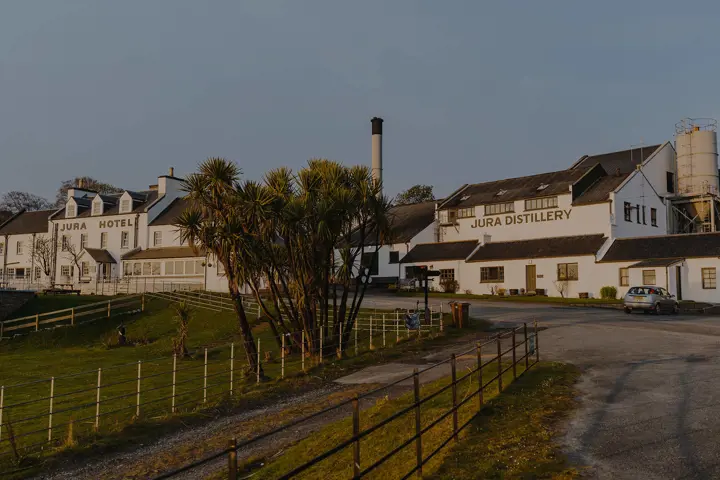
Isle of Jura Distillery
Reference: Jura Single Malt Scotch Whisky
Dear WHISKY:
What is the most essential aspect of Isle of Jura Distillery’s whisky-making?
Jamie:
Obviously, water and casks are important. But the spirit ultimately plays the biggest part. Joe uses this phrase quite a lot and I love it— “It’s the way the shape of our stills influences everything, the way we mash; it’s all part of it.” We’ve set the distillery up to make really good quality whisky, knowing the liquid and putting our characters to it.
Dear WHISKY:
How do you think your teamwork plays into this whisky-making?
Joe:
As Jamie said (read Part 1 of the article!), the collaborative effort is really key when it comes to whisky-making with Isle of Jura Distillery, because we have access to many different cask types and recipe styles. The possibilities are almost endless.
We all feel proud of being part of the Isle of Jura Distillery whisky-making team and put our names to it. Our whiskies are the best possible showcases of the fantastic Jura spirit that Jamie and his team make.
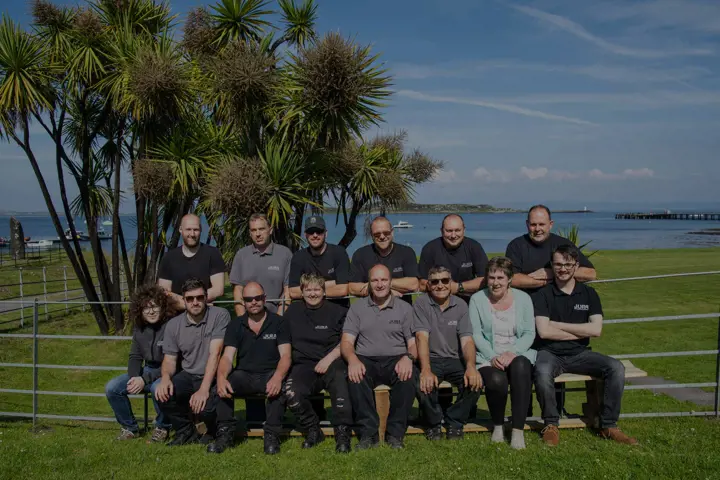
a team at Isle of Jura Distillery
Reference: Jura Single Malt Scotch Whisky
Dear WHISKY:
Isle of Jura Distillery is known for its tall stills.
What exact flavor of whisky does Isle of Jura Distillery want to achieve with them?
Joe:
Taller stills typically create a lighter, more aromatic style of spirit, as you increase the levels of reflux with the distillation process and the subsequent hearts-cut. In comparison to smaller, shorter, squatter and rounder stills, these might create a slightly heavier and oilier style spirit. This will also depend on the heating element.

pot stills famous for their hights
Reference: Jura Single Malt Scotch Whisky
Dear WHISKY:
Why did Isle of Jura Distillery decide to use taller stills in the first place?
Joe:
When the distillery was reopened back in 1963, the team designed the still shapes to create this unique flavor of the spirit. Because Isle of Jura Distillery wanted to create something that could be used in blends as well, they always had the intention to create that lighter spirit and the tall still shape.
Dear WHISKY:
In addition to the light and aromatic flavor, what makes the JURA whisky distinct from others?
Joe:
Having a lot of character is essential. It’s complex, fragrant, and fruity. Getting the balance right is important too, because overly light and delicate flavor wouldn’t work well with long-term maturation. We also need to create a spirit with a certain amount of texture, weight, and inherent complexity so that it can stand up when we mature it. Otherwise, it is too delicate, and the maturation will just completely take over.
Dear WHISKY:
What do you mean by “the maturation will take over”?
Joe:
For example, some spirits are absolutely beautiful when they’re unaged, but the extractors of casks can quickly transform it in a way that doesn’t do it justice. So we need to make sure that the spirit has the coastal element and Isle of Jura Distillery’s characters which are light, aromatic, and fruity, but not too light to use in the maturation process.
Dear WHISKY:
Is keeping the balance also important to attract many consumers?
Joe:
Yes, in order to target diverse people. For JURA’s whiskies, there’s also the approachable element balancing together with the complexity. Over the years, I’ve tried a number of fascinating drinks that are extremely complex, and they gave me a good drinking experience. However, sometimes the complexity can get in the way of the enjoyment of drinking the spirit. Hence, we’re trying to get the balance of being intriguing and complex, but at the same time, making them approachable. So, our whiskies are something that you can still enjoy with friends, but enthusiasts can pick up the intriguing nuances of the spirit.
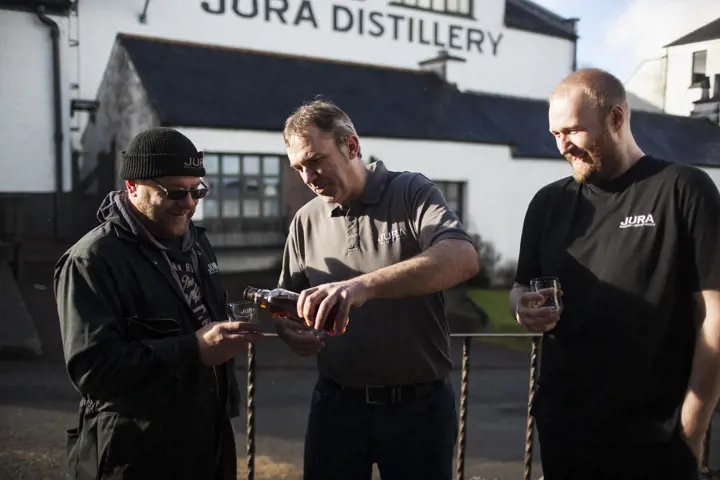
whisky from Jura enjoyed by a variety of people
Reference: Jura Single Malt Scotch Whisky
Dear WHISKY:
What does keeping this balance mean to you?
Joe:
This is basically to have respect for the spirit. If we don’t respect the spirit but use raw materials that have too much of an impact, we would lose the charm and the character that Jamie and the team worked so hard to create. That, to me, is the real shame in the whisky-making process, and ultimately what we bottle could be anything made in any cask if you don’t have the core identity of Isle of Jura Distillery and the strong sense of place in the spirit.
Dear WHISKY:
Are you planning to use more peat and create heavier tastes, utilizing Jamie’s experience at Kilchoman Distillery in Islay?
Jamie:
I would love us to have a strong identity on our own that is separate from the peated malts on the island of Islay. They do it well with their peat, so we do what we do so well. The core thing with Isle of Jura Distillery is the liquid identity, and what Isle of Jura Distillery is known for is non-peated whiskies. The liquid and spirit that we have is so delicate that it does not really work with the peat except when it is in very small doses.
Joe:
In terms of distillery exclusives, they have been peated and shown particularly well. However, the light flavor is a lovely point of difference to our Islay neighbors as well. But if we are to use peat, we’ll do small quantities with a suitable point of difference because it has to have its place in the market.
Dear WHISKY:
How does the aging of maturation come into whisky-making?
Jamie:
At Isle of Jura Distillery, once maturation starts getting into that high teen, we need to make sure that they still have the strain of what Isle of Jura Distillery stands for within every single whisky, as opposed to it being a wood-led spirit. You can over-extract and lose the character along the way, and that’s the challenge.

casks matured at Isle of Jura Distillery
Reference: Jura Single Malt Scotch Whisky
Dear WHISKY:
What are some of the best matured whiskies Isle of Jura Distillery has at the moment?
Jamie:
We have the older distillery releases such as the 31 year old, and it’s one of the best whiskies I’ve ever tasted. But if you were to ask me where Isle of Jura Distillery’s spirit is at its best, I would say it’s within the 14 to 18 range. It just lends itself well to the influence of the cask, and this is the tipping point to make sure that we don’t go over the line.
Joe:
At the moment, we seem to be in a bit of a sweet spot with the ages of these vintage whiskies that we are working with. From around 2007 to 2009 and slightly older, they’re absolutely wonderful now. Some whiskies and spirits can excel at different age ranges. I had 3 year old whiskies and 60 year old whiskies that were both great, so this is very much spirit-dependent. Each distillery and each spirit type will have a preferred maturation path with an age window in which it peaks. One of the perks of the recipe creation process is that you can come across specific vintages or parcels that have become beautiful in their own style by being matured and having nature work on its own to create something wonderful.
Dear WHISKY:
How do you check on whiskies that are being matured?
Joe:
By Sampling, to keep an eye on it. If you don’t, then it’s 50-50. It could turn into something exceptional as nature itself could create wonderful spirits, or it could go down a different path and deviate, in which case we have to remedy the situation by coming up with a different blend or recasking it. There’s very little waste because we have so many tools and processes available. We can divert it and put it down different paths to help restore that character and utilize it in the future.
Jamie:
This is certainly the fun part of the whisky-making process. We get a parcel of three or four different casks that are all right beside each other, and they all have varying degrees of difference to them. That’s the exciting part, since we are able to see what they would become, the journey that they are on and what the spirit can look like in two or three years or even further out. This is like looking at the future-proofing of the distillery. There are loads of these little pockets of brilliance within the warehouses that we can tap into when we need to.
Joe:
They all tell a different story by living their own life. That gives us endless possibilities to work with. It’s one of the best aspects of working in this industry.
Dear WHISKY:
What are some new projects that Isle of Jura Distillery is working on recently?
Jamie:
One of our biggest focuses is sustainability. We’re currently putting in new biomass boilers, such as new houses. This is to ensure that the distillery is going from strength to strength. We’re doing our best for the community and the climate to make sure that we’re putting our right foot forward.
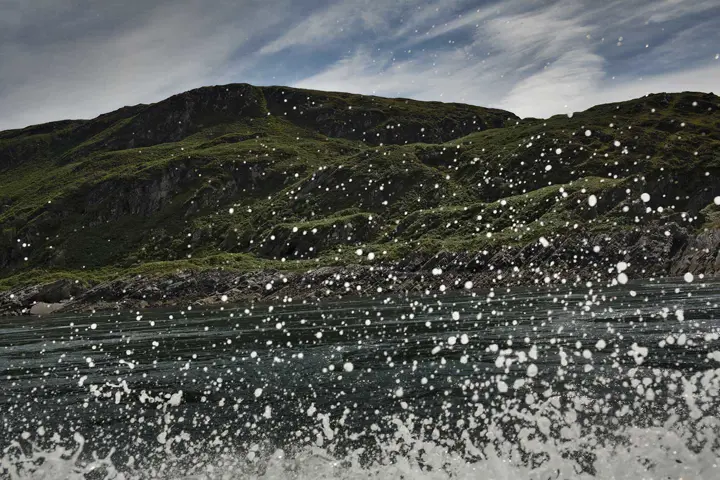
Protecting the nature of Jura
Reference: Jura Single Malt Scotch Whisky
Dear WHISKY:
Why did you guys start the project for sustainability?
Jamie:
It is a company initiative as well, not just within the distillery. Isle of Jura Distillery is a great test stove for us. Jura Island is one of the most untouched islands; only 2% of the actual island belongs to the community there, and the rest is completely wild. I think the closer we become as a distillery to our own surroundings, the better it is, and being close to the distillery means that we have to care about the environment. We are doing everything to be an example for not just our own company but for every other distillery on Islay or in the mainland as well.
Dear WHISKY:
What are the specific measures you are taking?
Jamie:
We currently work off of kerosene boilers. When putting in biomass, Jura Island is a naturally hard place, and everything becomes about cost. Carbon footprint is difficult on the island as well, because we have to think about bringing tacticals of oil into the segregated island every week. However, biomass definitely puts us in the right step.
Besides that, for every tree that we chop down, we plant four new trees. We’re moving away from diesel cars with electric forklifts, buses and vans.
Dear WHISKY:
Why does Isle of Jura Distillery release non-age statements?
Joe:
Age is not necessarily a sign of quality. Depending on the recipe style, certain whiskies may peak at a much younger age in comparison to others. It all really depends on the parcels of stock, the cask types, and the resulting flavor profile that you’re looking for.
The reason why we and the industry in general do the non-age statement is because we’re trying to convey the point that it’s not all about age. You can get fantastic whiskies at a comparatively younger age. When people see a comparatively younger age statement, they may think that it’s a sign of lower quality. However, it’s absolutely not true, because you can get wonderful whiskies around 8 or 6 years old.
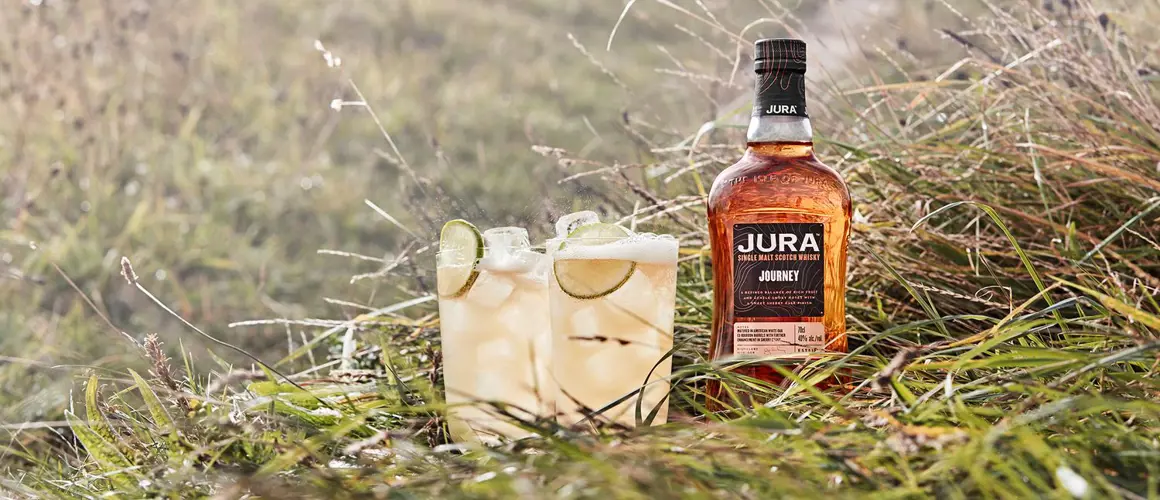
Jura Journey, non age statement
Reference: Jura Single Malt Scotch Whisky
Dear WHISKY:
Are there any whisky bottles that you got inspired by for a non-age statement?
Joe:
The first release of Chichibu Distillery, which was three years old, blew my mind. Prior to that, I was used to drinking older whiskies, so I thought it was an extremely bold move to release something at that age and be proud of it as well.
Japanese whisky in general has been a bit of a trailblazer for non-age statements in some ways, which has helped the rest of the whisky industry around the world to reconsider the needs to push the industry forward from the traditional assumption of age statement. Ultimately, what we’re working on is a heritage craft. Jamie, myself and the rest of the whisky-making team here are custodians in keeping these traditions alive.
Dear WHISKY:
Would you want to purposefully create younger whiskies in Isle of Jura Distillery?
Jamie:
Jura had an eight-year-old release many years ago, and I want to go back to doing something like that, purely because it moves things forward and becomes a real representation of what we make. But there is still a barrier for people on the mass market of younger age being deemed lesser quality.
Dear WHISKY:
What would be important for that?
Joe:
The spirit quality from the production process is absolutely the key here, as that makes it more drinkable at a young age. I am a big fan of unaged spirits such as Eau De Vie (a category of brandy that is unaged and distilled from any fruit other than grapes), as they can be an accurate representation of raw materials, whether they are fruit bases or cereal bases. When it comes to fermentations, this is the same for sake as well. When you get different rice varieties and types of sake, I love being able to taste the elements of those raw materials, or at times, you’re tasting the environment, the land and the climate alongside the agricultural products. They all form part of the complexity of the ferments or the spirits.
Dear WHISKY:
What’s your thought about “tasting raw material”, Jamie?
Jamie:
I totally agree with Joe. At BrewDog, we tried really hard to make a flavor-driven spirit without commercial constraints. For example, unlike the whisky industry’s emphasis on yield-driven malts, the beer industry uses hundreds of barley varieties, each chosen for its unique flavor rather than its yield. Old-school flavor-driven malts like Maris Otter or Golden Promise can be tasted in your glass, and that’s exactly what carries through the process and stays in the spirits at the end. While this approach can be challenging with heavier spirits, which could lose the malt flavor, it allows us to highlight the malt flavors in our lighter whiskies.
Dear WHISKY:
JURA whiskies became so popular partly because of their affordable prices, in addition to the delicate, complex flavors.
What are your thoughts on this pricing?
Jamie:
The great thing about Isle of Jura Distillery and its non-age statement is that it is accessible in terms of price range. The light character of flavor is the introductory level for so many different people. That is what I love about the type of range that we provide. You are able to try the beautiful light spirits in different casks for a relatively accessible price.
Joe:
The price point is a hugely important factor, because sometimes prices can be the barrier for entry-level people who want to come into whisky. It is a fantastic way to get people into the category, as they would still get incredible age blends that are extremely complex. Cheaper blended whiskies are also great to mix and to drink with friends.
Dear WHISKY:
Are there any ideas for new whisky collections?
Joe:
There are always projects on the go for whisky collections. As we covered earlier, inspiration could come from absolutely anywhere including artworks. At the moment, we are particularly interested in the sensory experience of nature with color. In particular, the island environment is an essential element in terms of how it looks and makes you feel with the hues that you get on the island as the seasons change. So this may form a future Jura release.
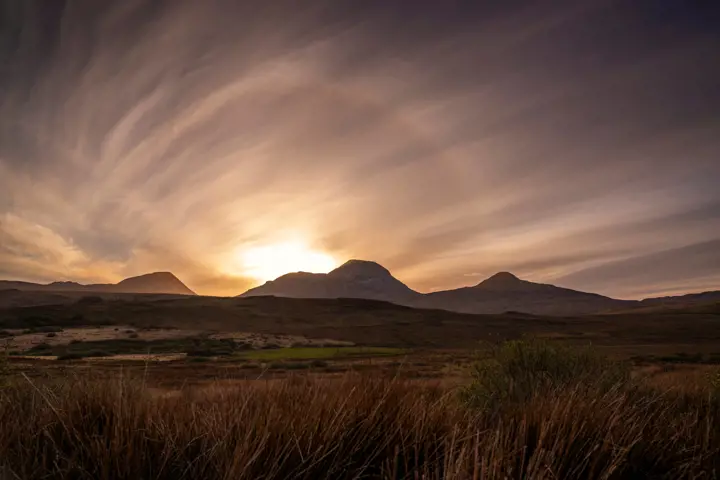
The nature of island inspires ideas for new whisky
Reference: Jura Single Malt Scotch Whisky
Dear WHISKY:
I love that you are getting inspiration from the nature of Jura Island!
Joe:
Another thing is music. Every year, we have a music festival, and I think music is a big part of Gaelic culture in general. I’m personally a big fan of either traditional music or jazz, so for example, I would love to see a jazz influenced Isle of Jura Distillery release in the near future and adopt the creative process that some of the great jazz musicians of the past have used when they create their music. I think there are a lot of fun and exciting things that we can do, and the possibilities are endless.
Dear WHISKY:
How about your idea, Jamie?
Jamie:
I believe the plans we have for the next five years in terms of releases are in the sweet spot with optimum chances. We actually just had a new release come out, the 15-year-old sherry cask. It is an exclusive release in Taiwan. I’m very excited to see how this will land. I love the 12 year old sherry cask right now, and the 15 is an evolution of it. They’re different, but both stand out as brilliant whiskies, but the 15 year old is becoming my new favorite. I would love to see something older too, but I will leave it up to Joe and his team.
Joe:
There may be something in the pipeline, a slightly older age statement of a sherry cask maturation. But everything that we create for the future, no matter what the age statement or maturation path it is, it always has to champion the Jura spirit with the distinct characteristics and qualities in the spirit that Jamie and his managing team instill.
Anything we would release needs to have their creative concept accompany the characters. Whether it’s color in nature or music, it always has to coexist with the Isle of Jura Distillery’s spirit style and make sense. It is not just a marketing story. It has to be true to the spirit itself.
Dear WHISKY:
Could you give Dear WHISKY’s readers messages at the end?
Jamie:
If you’re ever on Jura, please let us know and I will gladly show you guys around. Everyone is welcome.
Joe:
We would love to host people on Jura. The best time of year would be Fèis Ìle, which is the Islay Whisky Festival. Jura also gets involved in that, and it is the beginning of June. That is the perfect time for people to come over and see the distillery and try wonderful whisky.
Jamie:
Also, Joe and I would obviously love to go to Japan, it’s one of my favorite places in the world.
This is the end of our interview! Thank you so much for taking your time and reading to the end!
We want to appreciate Jamie and Joe for joining us and sharing such amazing stories about Jura and important takeouts of the whisky industry.
I hope you enjoyed this article, and please try out some of the amazing Jura whiskies when you find the beautiful bottles!